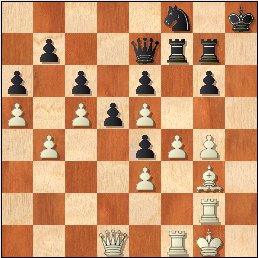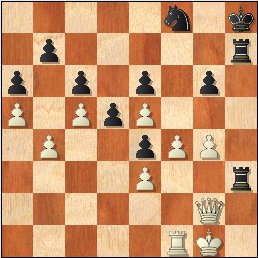

#1. After 36...Kg8-h8
Assess the position? Did Black just blunder?
#2. After 41...Rh4-h3
Assess the position? Should, White play 42.Pf5?
Monthly Special $$ offers - FREE books and Savings
Improve your Chess via Active Learning
ACTIVE LEARNING is any strategy that involves students in doing things and thinking about the things they are doing (*)
Skip the test and going directly to the lecture, or start by attempting to figure out on your own what is going on in each of the positions I will be talking about and then proceed to the lecture. If you chose the latter, spend 5-15 minutes on each diagram and record your evaluation and move / plan for the side whose turn it is and sample variations. Then compare your ideas with mine. Let me know how you like the test and the lecture
Test yourself:
Level - intermediate through advanced.
1. Check whose move it is / Read the question.
2. Evaluate position (i.e. White is Better, or Black is Winning, or Equal...)
3. Find the Best move and, if necessary, support it with variations. <<CALCULATE thoroughly!!>>
4. Answer the question (if there is a specific one)
 |
 |
|
#1. After 36...Kg8-h8 Assess the position? Did Black just blunder? |
#2. After 41...Rh4-h3 Assess the position? Should, White play 42.Pf5? |
STOP - the lecture begins below.
Creating Material Imbalance to Change the Dynamics of the Game.
How well do you play in the situations when you have advantage vs. when position is balanced vs. when you are worse? One way to improve your game is by finding an answer to this question and working on addressing the situation where you perform the worst. In my new book in the chess exam series that should come out later in the year, I will help you in answering this question by showing how your overall rating is allocated between the three sub-ratings (advantage, balanced, and worse). You can combine my assessment with your own to see if they pointing to the same weak area. I also offer a handful of quick tips on how to improve.
One specific issue is a subject of this article: when you dislike your position and want to change the situation, consider a small material sacrifice to create an unusual material imbalance and thereby alter the dynamics of the game. Among the most popular sacrifice are: a Piece for 2 Pawns, an exchange, and the Queen for a R and a Piece. Overall, this sacrifice are fairly minor (resulting in approximately one Pawn deficit), but the effect on the situation could be dramatic. This is due to both - the specifics of the position and the psychological effect on both players.
In this article I show your two examples from the same game – Alekhine – Euwe, Amsterdam 1926, match, game 5, (this example wasn’t included in my new book).
|
Diagram #1
After 36...Kg8-h8 |
Assess the position? Did Black just blunder?
Why did Euwe play 36...Kh8? It looks like a blunder, isn't it? Alekhine, after very brief thinking, played the direct 37.Bh4. Perhaps he thought that Euwe simply blundered; in fact, Euwe didn't . He just didn't like his solid, but passive position and decided to completely change the flow of the game by sacrificing his Queen. Let see what happened: 37... Qxh4 [the other Q moves are met by 38.Bf6+-] 38.Rh2 Rh7 39.Rxh4 Rxh4= , Alekhine won the Q, but Euwe got a complete control over the only open file.
Just two moves ago, Alekhine had a solid position with minimal advantage and virtually no risk. Now he has a material advantage, but no obvious way to attack, and also has to worry about Black's aggression along the h-file. Just like prior to the sacrifice, the position remains nearly equal, but the dynamics has changed dramatically.
After 40.Qe2 Rfh7 41.Qg2 Rh3, we reached the position on the diagram 2 |
|
Diagram #2
After 41...Rh4-h3 |
Assess the position? Should, White play 42.Pf5?
Black is threatening the e3-P and Alekhine can't ignore it. The solid 42.Re1 would have likely allowed White to defend safely and lead to a draw, e.g. 42.Re1 Kg8 43.Pg5 Rf3 44.Qg4 Rhh3 45.Kg2= Rxe3 46.Qxh3 Rxe1 47.Kf2=.
However, now Alekhine didn't like to continue a passive defense and decided to give back the material, but create tactical complications. Hence he played the risky 42.Pf5 instead. After 42...Pgxf5 43.Pxf5 Rg7, Black won the Q, but had to give up both R and the N. 44.Pxe6 Nxe6 45.Rf6! Rhg3 [45...Nxc5?? 46.Rf8+ Kh7 47.Rf7 Rxf7 48.Qxh3+] 46.Qxg3 Rxg3+ 47.Kh2 Rxe3 48.Rxe6. See diagram on the right.
Both players were happy with this endgame, Euwe felt that he had reached a winning position. Alekhine felt that he was able to transpose a passive position into a tactical R-endgame where he could out play his opponent.
Interestingly, both players were correct, to a certain degree. Indeed, after 48...Rf3, Euwe would have achieved a won position. His pawns are solid and his R is ready to stop the e-P and support his own Ps. Also, the Black K is ready to help the R when necessary.
Instead, perhaps tired after all of the complex shifts in the position, Euwe rushed with 48...Pd4?, missing one of Alekhine's tactical ideas. With the Black R passive, and the central Ps vulnerable, the only piece Alekhine had to worry about was the Black K. Hence, he played 49.Rg6, cutting it from the e-P. Black can't save his central Ps. The draw was agreed. Here is a sample line - 49.Rg6 Rf3 50.Rg4 e3 51.Rxd4= |
Summary:
I wanted use these examples to show how the flow of the game can be changed by a small material sacrifice. It not only has an effect on the position, but also psychological effect on both players. However, a proper assessment (which Euwe did in the diagram 1) and an accurate calculation (which Alekhine failed to do in the diagram 2) is required before you execute your sacrifice. Otherwise, a solid, but passive position could collapse. Still, even if this should happen, all is not lost. When the chess factors are against your, psychological factors could possibly rescue you, just like it happened to Alekhine in the end.
==============================================================================================
What do you think about this article? How did you do? For comments,
corrections send email or use
this
form
More on chess training (serious and enlightening) in my books:
|
|
Chess Exam and Training Guide (2004) $24.95 + shipping Chess Exam and Training Guide: Tactics (2007) $19.95 + shipping CE + CE Tactics (Holiday Special! Free chess cartoon calendar $8, while supplies last) - $39.95 - insured shipping in US is included
The new Chess Exam is coming ... |
Copyrighted @ 2009 Igor Khmelnitsky
For comments or permission to reprint please send inquires via email or this form
(*Bonwell, C., & Eison, J. (1991). Active learning: Creating excitement in the classroom (ASHE-ERIC Higher Education Report No. 1). Washington, DC: George Washington University, p. 2)